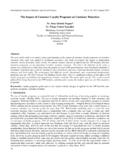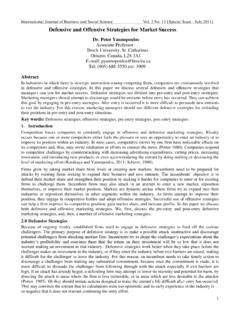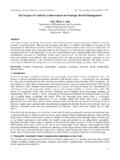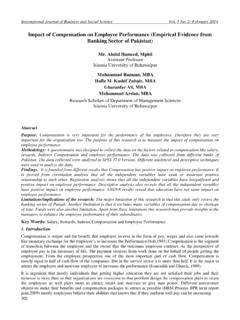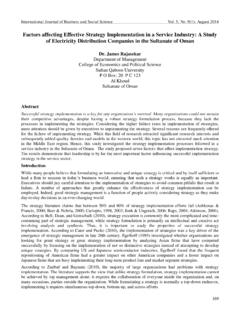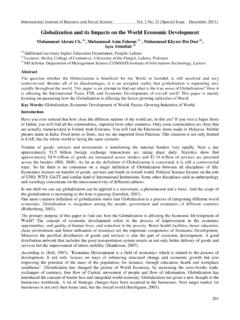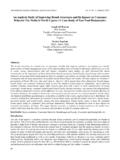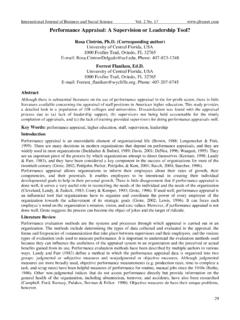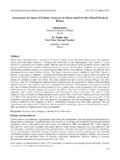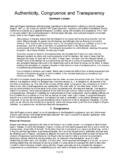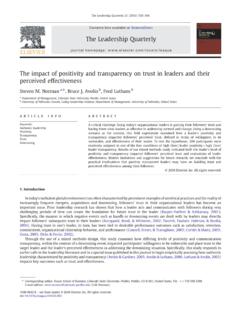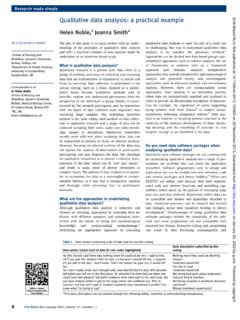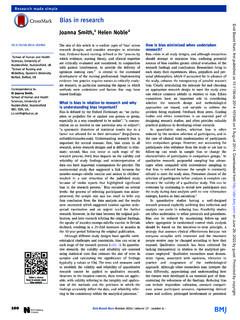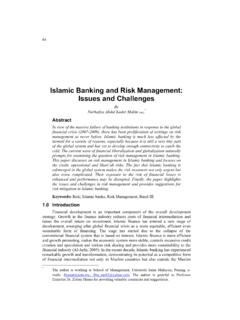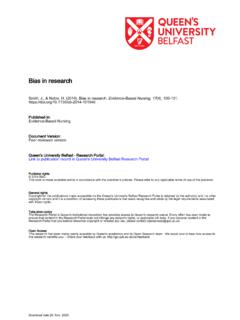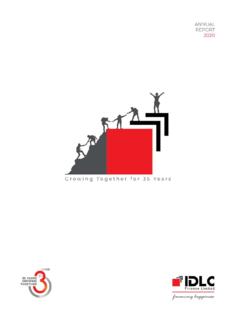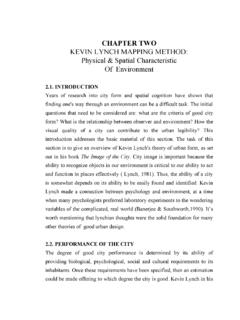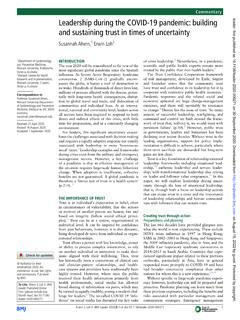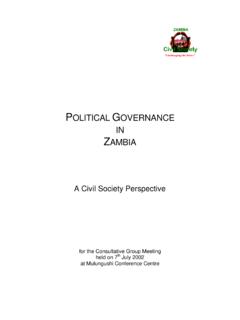Transcription of Students’ Perceptions of Math Assessments
1 International Journal of Business and Social Science Vol. 3 No. 2 [Special Issue January 2012] 63 Classroom Assessments in Mathematics: High School students Perceptions Minghui Gao Assistant Professor of Secondary Education Department of Teacher Education Arkansas State University United States of America Abstract This study examined high school students Perceptions of mathematics classroom Assessments . 248 American students gave valid responses to a questionnaire. Data analysis involved counting frequencies, calculating percentages, and running Chi-square tests. Results reveal that students felt a strong congruence between mathematics assessment, planned learning and adequate transparency regarding the purpose and forms of the assessment, inadequate authenticity in assessment tasks, and had little or no say in the assessment planning process.
2 Results show the most variance in the questions regarding accommodation of student diversity. Gender difference was observed in assessment authenticity and transparency . Results are discussed in regard to previous literature and future research. Key words: mathematics, classroom assessment, perception, high school student 1. Introduction Classroom Assessments are an essential component of the teaching and learning process (Goodrum, Hackling, & Rennie, 2001). Such Assessments are not only a means to assign grades and determine whether students achieve objectives but have also become a learning tool (Watering, Gijbels, Dochy, & Rijt, 2008).
3 Traditionally, assessment forms and tasks employed in schools have been overwhelmingly decided by teachers and administrators (Fisher, Waldrip, & Dorman, 2005). However, for effective learning to occur, students need to understand assessment processes and the implications for themselves as learners (Schaffner, Burry-Stock, Cho, Boney, & Hamilton, 2000). To this end, students must be involved in decisions about classroom assessment. Despite this knowledge, little contemporary research has addressed student involvement in the assessment planning process (Dorman & Knightley, 2006). The present paper reports on one study that examined high school students Perceptions of classroom assessment in mathematics.
4 Classroom Assessments in Mathematics According to a recent report by the Organization of Economic Co-operation and Development (OECD, 2005), classroom Assessments summative and formative are integral to the education process. Summative Assessments are a major detector of what students have learned and how schools account for student performance. Through formative Assessments , teachers monitor student progress, provide students feedback, and adjust instructional approaches toward improved teaching and learning. Overall, classroom Assessments are effective strategies for improvement of student learning. Classroom Assessments in mathematics have encountered a wide range of barriers to student achievement.
5 Some examples of these barriers include: (1) perceived tensions between teacher-made formative Assessments and highly visible summative assessment for school accountability (OECD, 2005); (2) a focus on recall of isolated items of knowledge (Black & William, 1998; Crooks, 1988); (3) inadequacy in aligning assessment tasks with students real-life situations (Gulikers, Bastiaens, Kirschner, & Kester, 2008); (4) inadequacy in student consultation regarding what should be included in assessment tasks (Schaffner et al., 2000); (5) a secretive process of setting criteria for judging student performance (Schwarz, 1992); (6) inequity or biases against students of diverse backgrounds (Lane, 1993; Pullin, 1993); and (7) a lack of awareness that gender has an effect on student performance on mathematics Assessments .
6 Concerning this final barrier, certain assessment formats favor boys more than girls (Kovas, Haworth, Petrill, & Plomin, 2007); boys do better under time pressure than girls (de Lange, 1999); and girls fare better when more language is involved (van den Heuvel-Panhuizen & Vermeer, 1999). To improve student achievement, mathematics assessment should be congruent with planned instruction (Reynolds, Doran, Allers, & Agruso, 1995), relate to the students real world experiences (Gulikers et al., 2008), and give every student the optimal opportunity to demonstrate mathematical power (de Lange, 1999). The Special Issue on Contemporary Research in Business and Social Science Centre for Promoting Ideas, USA 64 By including students in the teaching-testing-grading cycle, the validity of the assessment processes can be enhanced and invalid assessment instruments that result in very high failure rates can be avoided (Steinberg, 2000).
7 students will also learn throughout the assessment when expectations and scoring procedures are openly discussed and jointly negotiated (de Lange, 1999). students Perceptions of Classroom Assessments students hold clear views on most aspects of school life such as how they are assessed (Dorman & Knightley, 2006). students also have great concerns about the importance and fairness of assessment tasks, their congruence with classroom learning and relevance to the real world. According to Cavanagh, Waldrip, Romanoski, and Dorman (2005), student views of classroom assessment comprises five characteristic elements: congruence with planned learning, authenticity, student consultation, transparency , and accommodation of student diversity.
8 Ideally, students should affirm the following: (1) assessment tasks align with the goals, objectives, and activities of the learning program; (2) assessment tasks feature real-life situations that are relevant to the students ; (3) students are consulted and informed about the forms of assessment tasks being employed; (4) purpose and forms of assessment tasks being used are clearly conveyed; and (5) all students have an equal chance of completing assessment tasks. Table 1 Purpose and Description of the Items in the students Perceptions of Assessment Questionnaire (adapted from Dorman & Knightley, 2006) Items Element Description Exemplary Item 01-05 congruence with Planned Learning The extent to which assessment tasks align with the goals, objectives and activities of the learning program.
9 My math assignments / tests are about what I have done in math class. 06-10 Authenticity The extent to which assessment tasks feature real life situations or those are relevant to the learner. I find math assessment tasks are relevant to what I do outside of school. 11-15 Student Consultation The extent to which students are consulted and informed about the forms of assessment tasks being employed. I have a say in how I will be assessed in mathematics class 16-20 transparency The extent to which the purposes and forms of assessment tasks are well-defined and clear to the learner. I am clear about what my teacher wants in my math assessment tasks. 21-24 Accommodation of Student Diversity The extent to which all students have an equal chance at completing assessment tasks.
10 I have as much chance as any other student at completing math assessment tasks. Guided by this five-element conceptual framework, Cavanagh et al. (2005) developed the students Perceptions of Assessment Questionnaire (SPAQ). The SPAQ includes 24 items, each in the form of a statement ( , my assignments/tests are about what I have done in class) and uses a 4-point Likert scale (0 = almost never; 1 = sometimes; 2 = often; and 3 = almost always). During data analysis, these items are collapsed into five subscales. Table 1 presents the five subscales and their respective description. Scale 1 (Items 1-5) measures the element of congruence with planned learning; Scale 2 (Items 6-10) measures authenticity; Scale 3 (Items 11-15) measures student consultation; Scale 4 (Items 15-20) measures transparency ; and Scale 5 (Items 21-24) measures accommodation of student diversity.
